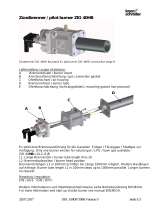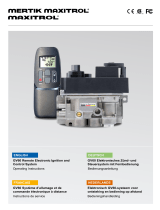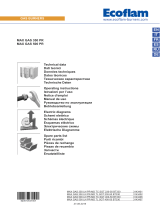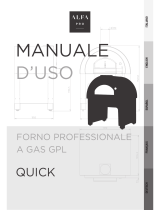
Gasbrenner
Gas burner
GBS – H
EN
D
BETRIEBSANLEITUNG
Bitte lesen und aufbewahren!
Alle in dieser Betriebsanleitung aufgeführten Tätigkeiten dürfen
nur von autorisiertem Fachpersonal durchgeführt werden
WARNUNG!
Unsachgemäßer Einbau, Einstellung, Veränderung, Bedienung
oder Wartung kann Verletzungen oder Sachschäden verursa-
chen. Anleitung vor dem Gebrauch lesen. Dieses Gerät muß nach
den geltenden Vorschriften installiert und Betrieben werden.
INSTRUCTIONS FOR INSTALLATION
AND OPERATION
Please do read these instructions carefully and keep them for
repeated use!
All the operations described hereafter must only be carried out
by a trained and authorized expert staff.
CAUTION!
Incorrect mounting, adjustment, modification, use or maintenance
may cause injuries or material damage. Please do read these
instructions for installation and operation before operation.
This gas burner must be installed and operated according to the
applicable regulations.
07/2015
M
QUAD
Beschreibung | English
M
QUAD

2/8 Industrial Burner Systems
www.ibs-brenner.de
ALLGEMEINE INFORMATION
GBS…H Gasbrenner sind für Betrieb mit niedrigen Luftdrücken
ausgelegt und für eine Vielzahl von Anwendungen geeignet. Mit
Brennerstein können die Brenner an Thermoprozessanlagen mit
bis zu 1.600°C Prozesstemperatur und Verbrennungs-lufttempe-
raturen bis zu 500°C eingesetzt werden.
Die Brenner der Baureihe GBS…H können mit allen sauberen
industrieüblichen Gasen betrieben werden. Die Brenner sind für
Nennleistungen von 750 kW bis 5000 kW erhältlich. Wahlwei-
se sind zwei unterschiedliche Brennersteinformen verfügbar:
konisch öffnend und konisch schließend. Mit dem konisch
öffnenden Brennerstein wird eine wenig turbulente lange weiche
Flamme erreicht, der konisch schließende Brennerstein bewirkt
eine kürzere, schmalere und stärker turbulente Flamme.
Die Brenner werden mittels Zündbrenner gezündet.
VOR DER INSTALLATION
Nach Erhalt sind alle Positionen der Lieferung anhand des Liefer-
scheins auf Vollständigkeit und Unversehrtheit zu überprüfen.
Bei längerer Lagerung ist sicherzustellen, dass die Ausrüstung
vor Witterungseinflüssen, insbesondere Feuchtigkeit, ausrei-
chend geschützt ist. Schäden infolge nicht sachgemäßer Lage-
rung begründen keine Gewährleistungsansprüche.
TECHNISCHE DATEN
GENERAL INFORMATION
GBS…H gas burners are designed for operation with low air pressures
and they can be used for a large number of applications. Burners with
burner tile could be used in thermoprocessing plants with a process
temperature up to 1.600°C and combustion air temperature up to
500°C.
The burners of the series GBS…H can be operated with all clean, in-
dustrial common fuel gases and they are available in a range from 750
kW up to 5.000 kW nominal capacity. There are two different types of
burner tiles available: diverging and converging. Using the diverging,
i.e. conically opening burner tile a long, soft and less turbulent flame is
produced. Whereas the converging, i.e. conically closing burner tile is
producing a shorter, smaller and more turbulent flame.
The burners are ignited by a pilot burner.
BEFORE INSTALLATION
Please check if all items of the consignment are complete according to
the delivery note and if they are without damage. In case of a longer
storage period, please ensure that the goods are well protected from
climatic influences, especially moisture. Damages caused by inadequate
storage do not constitute any warranty claim.
TECHNICAL DATA
Brennertyp
Burner type
Nennleistung kW
nominal capacity
Flammenlänge
Flame length
Durchmesser
Flame diameter
Geschwindigkeit
Flame velocity
Kaltluft
ambient air
Warmluft
preheated air
GBS 700 H 750 500 1,7 0,5 40
GBS 1000 H 1000 650 1,8 0,5 55
GBS 1500 H 1500 1000 1,8 0,5 65
GBS 2000 H 2000 1300 2,1 0,9 85
GBS 2500 H 2500 1600 2,8 1,3 70
GBS 3500 H 3500 2300 2,8 1,3 75
GBS 5000 H 5000 3300 3 1,4 60
1)
Erdgas H im Freibrand
Natural gas H on open firing
2)
sichtbare Flamme
Visible flame
3)
Austrittsgeschwindigkeit der Reaktionsgase in der Brennermündung
Exit velocity of the reaction gases in the burner outlet
4)
Luftvorwärmung auf Anfrage
Air preheating on request

Industrial Burner Systems 3/8
www.ibs-brenner.de
EINBAU DES BRENNERS
HINWEIS:
Bei Verwendung einer UV-Zelle ist der Brenner so zu instal-
lieren, daß der UV-Sensor oberhalb der Brennermitte liegt
um das Eindringen von Feuchtigkeit und Staubpartikeln aus
der Ofenatmosphäre zu verhindern. Diese können die unge-
hinderte Sicht der UV-Zelle auf die Flamme behindern und
zu Störungen des Brennerbetriebs führen.
1. Die für die Installation des Brenners vorgesehene Öffnung am
Ofen / Brennraum sollte etwa 15 mm größer sein als der
Außendurchmesser des Brennersteins.
2. Am Ofen sind die für die Aufnahme des Brenners vorge-
sehenen Bolzen von geeigneter Größe und Länge anzusch-
weißen.
3. Inneralb des Ofens sind überschüssiges Feuerfestmaterial,
Steine, keramische Fasermatten oder Platten zu entfernen.
Dazu ist die Feuerfestzustellung in einem Durchmesser etwa
75 mm größer als der Außendurchmesser des Brennersteins
auszuschneiden.
4. Flanschdichtung des Brennersteins über die am Ofen ange-
schweißten Aufnahmebolzen für den Brennerstein streifen.
5. Brennerstein am Ofen befestigen und mit geeigneten Siche-
rungsscheiben und Muttern sichern.
6. Isolierdichtung in die dafür vorgesehene Aussparung des
Brennersteins einlegen.
7. Flanschdichtung des Brenners über die Bolzen des Flansches
am Brennerstein streifen.
8. GBS…H-Brenner am Flansch des Brennersteins installieren
und mit geeigneten Sicherungsscheiben und Muttern sichern.
9. Auf der Innenseite der Ofenwand den Ringspalt zwischen
dem Brennerstein und der Öffnung in der Feuerfestzustel-
lung mit keramischen Fasermatten fest zustopfen. Darauf
achten, ass die Fasermatten für eine höhere Temperatur
geeignet sind als die Ofenraumtemperatur. Um Beschädigun-
gen an der Ofenhülle, dem Flansch des Brennersteins, dem
Brennerflansch und dazugehörigen Dichtungen zu vermeiden
ist es wichtig die Fasermatte fest zu packen. Nach dem
erstmaligen Betrieb des Brenners ist die Fasermatte nochmals
zu stopfen.
INSTALLATION OF THE BURNER
NOTE:
Using an ultraviolet (UV) cell, the burner should be positi-
oned in a way that the UV sensor is located above the hori-
zontal centerline of the burner to prevent moisture and air-
borne debris which come from the furnace atmosphere from
blocking the UV cell’s sight to the flame and disturbing the
burner’s operation.
1. Furnish an opening in the furnace shell approx. 15 mm larger
than the outside diameter of the burner tile for the installation
of the burner.
2. Weld the studs of appropriate size and length to the furnace
shell for the mounting of the burner.
3. Remove poured refractory, brick, ceramic fiber blanket or
board from inside the furnace via a round cut-out in the re-
fractory lining which has to be approximately 75 mm larger
than the outside diameter of the burner tile.
4. Slip the tile mounting gasket over the studs for the burner
tile on the furnace shell.
5. Install the burner tile on the furnace shell and secure with
appropriate lock washers and nuts.
6. Place the insulating gasket into the corresponding recess
of the burner tile.
7. Slip the burner mounting gasket over the studs on the
burner tile flange.
8. Install the GBS…H burner on the burner tile flange and
secure with appropriate lock washers and nuts.
9. From inside the furnace, pack ceramic fiber blanket rated for
a higher temperature than the furnace into the annular ope-
ning between the burner tile and opening in the refractory
lining. It is important that the fiber is well packed to ensure
that the furnace shell, burner tile flange, burner flange and
associated gaskets will not be damaged. Fiber must be repa-
cked after initial firing of the burner.

4/8 Industrial Burner Systems
www.ibs-brenner.de
GAS UND LUFTANSCHLÜSSE
HINWEIS:
Alle Gas und Luftleitungen sind spannungsarm zu verlegen.
Es wird empfohlen flexible Ver-bindungen zu verwenden.
1. Luftleitung bis zum Brenner verlegen, dabei scharfe Rich-
tungsänderungen vermeiden, diese können Messungen des
Volumenstroms verfälschen und führen zu erhöhten Druck-
verlusten.
2. Gasleitung bis zum Brenner verlegen. Dabei scharfe Rich-
tungsänderungen vermeiden, diese können Messungen des
Volumenstroms verfälschen und führen zu erhöhten Druck-
verlusten.
3. Zündbrenner in die vorgesehene Öffnung einbauen. Gas und
Luftleitungen zum Zündbrenner verlegen und anschließen.
HINWEIS:
Die Gaszufuhr zum Zündbrenner ist ausreichend zu dimen-
sionieren um zu hohen Druckverlust zu vermeiden. Vor
Anschluss des Zündbrenners ist die Leitung zu spülen um
Verschmutzungen zu beseitigen.
4. Bei Verwendung einer UV-Zelle ist diese mit sauberer und
trockener Luft kühlen
5. Nach Abschluß der Installationsarbeiten alle Rohrverbin-
dungen auf Dichtheit überprüfen. Alle nicht benötigten
Anschlüsse am Brenner verschließen
6. Alle Schraubverbindungen am Brenner auf Dichtheit und
Festigkeit überprüfen.
ACHTUNG:
Für die richtige Abdichtung ist es wichtig, daß die Schrauben
der hinteren Brennerplatte ausreichend dicht schließen. Vor
jedem Versuch den Brenner zu starten ist zu prüfen, ob alle
Schrauben und Verbindungen dicht sind. Ein Leckagetest ist
durchzuführen. Geschieht dies nicht und die Gasleitungen
sind undicht können gefährliche Zustände auftreten.
GAS AND AIR CONNECTIONS
NOTE:
All gas and air piping must be installed with low tension only.
We recommend to use flexible connections.
1. Install the air line to the burner avoiding abrupt changes in
direction, because these could falsify measurements of the
volume flow and lead to higher losses of pressure.
2. Install the gas line to the burner avoiding abrupt changes in
direction, because these could falsify measurements of the
volume flow and lead to higher losses of pressure.
3. Mount the pilot burner into the corresponding opening.
Install gas and air lines to the pilot burner and connect them.
NOTE:
Size the pilot gas supply line sufficiently to avoid excessive
pressure drops. Prior to connecting to the pilot burner purge
the gas line to remove debris.
4. When using an UV cell, cool it with clean and dry air.
5. After termination of the installation works do verify that all
piping connections are tight. Close all connections on the
burner which are not required.
6. Check all bolted joints on the burner to ensure that they are
tight and gaskets are properly seated.
ATTENTION!
In order to ensure an adequate seal, it is important that the
burner back plate bolts are sufficiently tight. Before any
attempt is made to start the burner, check to ensure that the
bolts are sufficiently tight and conduct a gas leak test.
Failure to check and make sure that a satisfactory seal exists
by conducting a leak test could result in the formation of a
hazardous gas leakage condition.
ZÜNDUNG
Nachfolgend beschriebene Tätig-keiten sind nur von quali-
fizierten, geschulten und autorisiertem Personal durchzu-
führen. Andererseits kann es zu Feuer, Explosion, schweren
Körperverletzungen bis hin zu Todesfolge kommen.
Die manuelle Zündung des Brenners mittels einer Fackel wird
nicht empfohlen da dies zu gefährlichen Zuständen führen
kann.
IGNITION
Only qualified, trained and authorized personnel is allowed to do
the following activities. Violation to this could cause fire, explosion,
severe personal injury, or even death.
It is not recommend to ignite the burner manually by means of a
torch, because this could lead to hazardous conditions.

Industrial Burner Systems 5/8
www.ibs-brenner.de
ZÜNDUNG
1. Es ist sicherzustellen, daß der Zündbrenner dicht in den dafür
vorgesehenen Anschluss am Brenner eingebaut ist.
2. Das Zündkabel des Transformators mit dem Zündstecker auf
die Zündkerze des Zündbrenners stecken.
3. Überprüfen ob der Zündstecker richtig auf der Mitte der
Zündkerze steckt.
HINWEIS:
Eine einwandfreie Erdung des Zündbrenners ist herzustellen
um Schäden an Ausrüstung oder Personen zu vermeiden. Die
Verwendung kurzer Zündkabel wird empfohlen (ca. 1,5 m)
um die sichere und reproduzierbare Zündung zu erreichen.
Der Zündtransformator erzeugt eine Zündspannung von
5000 Volt. Die Zündung führt zum Auftreten einer offenen
Flamme. Während des gesamten Zündvorgangs ist zum
Zündkabel, zum Zündstecker und zu der Düse des Zünd-
brenners ein sicherer Abstand zu halten.
4. Sicherstellen, dass der Gasabsperrhahn geschlossen ist.
5. Ventilator oder Luftzufuhr starten.
6. Luftvolumenstrom zum Zündbrenner bis zum Maximum
freigeben.
7. Zündtransformator starten und überprüfen ob ein aus-
reichender Zündfunke im Zündbrenner auftritt.
8. Gasabsperrhahn vollständig öffnen. Während der gesamt
Dauer des Betriebs des Zündbrenners muß der Gasabsperr-
hahn voll geöffnet bleiben.
9. Zündbrenner so lange einstellen, bis sich eine scharfe blaue
Flamme mit hoher Geschwindigkeit bildet. Wird der Zünd-
brenner außerhalb des Hauptbrenners eingestellt, ist die
Einstellung eines Luftüberschusses empfohlen, um nach dem
Einbau in den Hauptbrenner eine korrekte Flamme zu errei-
chen. Die Einstellung des Gas-Luft-Verhältnisses erfolgt in drei
Schritten:
Kontermutter am Mischer lösen
wird die Einstellschraube am Mischer im Uhrzeigersinn
gedreht bewirkt dies eine Erhöhung der Luftmenge; wird
die Einstellschraube am Mischer gegen den Uhrzeigersinn
gedreht, bewirkt dies eine Verringerung der Luftmenge
Kontermutter am Mischer festziehen
10. Um den Zündbrenner abzustellen zuerst den Gashahn
schließen.
IGNITION
1. Check, if the pilot burner is threaded tightly into the pilot
port at the burner.
2. Connect the ignition wire of the transformer with the spark
plug cab to the spark plug of the pilot burner.
3. Check, if the spark plug cab is connected correctly to the
center of the spark plug.
NOTE:
Provide a faultless grounding of the pilot burner in order to
avoid damages of the equipment or persons. We recommend
to use short ignition cables (approx. 1,5 m) to ensure a safe
and repeatable ignition.
The ignition transformer generates an ignition voltage of
5.000 Volt. The ignition produces an open flame. Please keep
a safe distance to the ignition wire, to the spark plug cab and
to the nozzle of the pilot burner during the whole ignition
process.
4. Make sure that the gas shut-off valve is closed.
5. Start the fan or air supply.
6. Open the air volume flow to the pilot burner to the maximum.
7. Start pilot burner and check if a sufficient ignition spark is
generated in the pilot burner.
8. Open the gas shut-off valve completely. The gas shut-off
valve has to stay completely opened during the whole opera-
tion of the pilot burner.
9. Adjust the pilot burner until a sharp blue flame with high
velocity is produced. In case that the pilot burner has to be
adjusted from outside of the main burner, we recommend to
adjust an air surplus in order to generate a correct flame after
the pilot burner has been mounted into the main burner. The
adjustment of the gas-air-ratio has to be made in three steps:
Untighten the lock nut at the mixer
Turning the setting screw at the mixer in clockwise direction
will increase the quantity of air. Turning the setting screw at the
mixer in counterclockwise direction will reduce the quantity of air.
Tighten the lock nut at the mixer.
10. To stop the pilot burner, first close the gas shut-off valve.

6/8 Industrial Burner Systems
www.ibs-brenner.de
ERSTE INBETRIEBNAHME
GBS…H-Brenner werden typischerweise mit automatischen
Regelungssystemen betrieben. Die Brenner können über ihren
gesamten Regelbereich proportional geregelt werden.
ACHTUNG:
Alle Tätigkeiten zur Einstellung und Inbetriebnahme sind
ausschließlich von Personal mit Erfahrung im Umgang mit
Verbrennungssystemen, deren Sicherheits- und Regelungs-
technik durchzuführen.
ACHTUNG:
Vor Beginn der Inbetriebnahme ist zu überprüfen, daß die
gesamte sicherheitstechnische Ausrüstung korrekt arbeitet
und alle sicherheitsrelevanten Grenzwerte richtig gesetzt
sind.
ACHTUNG:
Kommt es während der Inbetriebnahme zu erfolglosen Zünd-
versuchen innerhalb der Sicherheitszeit des Feuerungsauto-
maten, kann dies zur Bildung eines brennbaren Gas-Luft-Ge-
misches mit der Folge einer Explosionsgefahr führen. Nach
einem erfolglosen Zündversuch sind alle Absperrventile für
den Brennstoff zu schließen und vor Beginn des nächsten
Zündversuches ist die Brennkammer zu spülen.
HINWEIS:
Der Brennerstein sollte während der Inbetriebnahme keinem
schnellen Temperaturanstieg ausgesetzt werden. Es wird
empfohlen, den Brennerstein bei kleiner Flamme und nied-
riger Brennerleistung für mindestens 8 Stunden zu trocknen,
erst dann darf das System den normalen Betrieb aufnehmen.
1. Nach der Installation ist der Brenner für die Inbetriebnahme
bereit. Die Vorgehensweise bei der Inbetriebnahme hängt
von den verwendeten Komponenten des Gesamtsystems ab,
bitte beachten Sie die Bedienungsanleitungen dieser Kompo-
nenten.
2. Der Verbrennungsluftdruck ist am Luftregelventil einzu-
stellen. Es wird empfohlen den Verbrennungsluftdruck bis zur
Zündung des Brenners auf dem kleinsten Wert einzustellen.
3. Der Gasdruck ist am Gasdruckregler einzustellen.
4. Falls dies noch nicht geschehen ist, ist den Anweisungen im
Abschnitt „Zündung“ zu folgen um den Zündbrenner zu
installieren und einzustellen.
INITIAL COMMISSIONING
GBS…H burners are usually being operated with automatic
control systems.
ATTENTION:
Make sure that only experienced staff which is familiar with
combustion systems, their safety and control systems will do
all activities for adjustment and commissioning.
ATTENTION:
Before commissioning make sure that the complete safety-
related equipment is working properly and that all limits
which are important for safety have been set correctly.
ATTENTION:
Failure to achieve ignition within the safety period of the
burner control during the commissioning could build up a
flammable gas-air-mixture with danger of explosion.
After failure to achieve ignition close all shut-off valves for
the fuel and purge the combustion chamber before starting a
new attempt to ignite.
NOTE:
Make sure that the burner tile is not heated up to fast during
commissioning.
We recommend to dry the burner tile during at least 8 hours
with a small flame and a low burner performance. Start nor-
mal operation only after this procedure.
1. After installation the burner is ready for commissioning. The
procedure of commissioning depends on the components of
the entire system. Please follow the operating instructions of
these components.
2. Set the pressure of the combustion air at the combustion air
valve. We recommend to adjust the pressure of the combustion
air to the lowest value until igniting the burner.
3. Set the gas pressure at the gas pressure regulator.
4. In case that the pilot burner has not yet been installed and
adjusted, please follow the instructions in the chapter “Ignition”
and install and adjust the pilot burner.

Industrial Burner Systems 7/8
www.ibs-brenner.de
ERSTE INBETRIEBNAHME
5. Nunmehr wird der Brenner wie folgt gestartet:
a. Es ist sicherzustellen, daß alle Absperrventile geschlossen
sind und daß sich das Luftregelventil bzw. die Luftregelklappe
in der Startstellung (Minimum) befindet
b. Starten des Verbrennungsluftventilators
c. Es ist sicherzustellen, daß der Gasabsperrhahn und die
Sicherheitsmagnetventile des Zündbrenners geschlossen
sind
d. Der Luftabsperrhahn des Zündbrenners ist vollständig zu
öffnen
e. Der Gasabsperrhahn des Zündbrenners und des Haupt-
brenners ist zu öffnen
f. Der Zündtransformator wird durch Start des Gasfeuerungs-
automaten aktiviert. Die automatischen Sicherheitsabsperr-
ventile des Zündbrenners werden vom Feuerungsautomaten
geöffnet und der Zündbrenner zündet.
g. Nach erfolgreichem Start des Zündbrenners werden die
automatischen Sicherheitsventile des Hauptbrenners vom
Feuerungsautomaten geöffnet.
h. Nach erfolgreichem Start des Hauptbrenners wird der Zünd-
brenner vom Feuerungsautomaten abgeschaltet.
6. Nachdem alle Brenner gestartet sind kann die Verbrennungs-
luftzufuhr bis zur Maximalposition erhöht werden
(entsprechend der maximalen Brennerleistung).
7. Nachdem die maximale Verbrennungsluftmenge eingestellt
wurde, ist die Gasmenge für die maximale Brennerleistung
einzustellen.
8. Die eingestellten Gas- und Luftmengen sind mittels Mess-
blenden zu überprüfen. Anstelle einer Messblende kann
der statische Luftdruck am Brennergehäuse zur Beurteilung
der Brennereinstellung herangezogen werden.
9. Der Brenner ist nunmehr in Kleinlast zu fahren und die
Beständigkeit des Regelverhältnisses zu überprüfen. Die
Schritte 6 bis 9 sind zu wiederholen bis die Einstellungen
korrekt und reproduzierbar sind.
10. Um die korrekte Brennereinstellung zu überprüfen ist eine
Abgasanalyse in Gross- und Kleinstellung des Brenners
durchzuführen.
11. Falls notwendig das System in den Automatikbetrieb versetzen.
12. Abstellen des Brenners:
a. Kleinstellung anfahren
b. Alle Brennstoffventile schließen
c. Den Ventilator nicht abstellen bevor der Feuerungsraum eine
Temperatur von 400°C erreicht hat
INITIAL COMMISSIONING
5. Now start the burner as follows:
a. Make sure that all shut-off valves are closed and that the
air control valve resp. the air control butterfly valve are in
start position (minimum).
b. Start the combustion air fan.
c. Make sure that the gas shut-off valve and the safety sole-
noid valves of the pilot burner are closed.
d. Completely open the air shut-off valve of the pilot burner.
e. Open the gas shut-off valve of the pilot burner and of the
main burner.
f. By starting the automatic burner control unit the ignition
transformer will be activated. The automatic safety shut-off
valves of the pilot burner will be opened by the automatic
burner control and the pilot burner ignites.
g. After successful start of the pilot burner the automatic bur-
ner control will open the automatic safety shut-off valves
of the main burner.
h. After successful start of the main burner the automatic
burner control will switch-off the pilot burner.
6. After having started all burners the combustion air inlet can
be increased up to the maximum position (according to the
maximum burner capacity).
7. After having set the maximum combustion air quantity,
adjust the quantity of gas for the maximum burner perfor-
mance.
8. Check the set quantities of gas and air by means of measu-
ring orifices. Instead of a measuring orifice, also the static air
pressure at the burner housing could be a basis to assess the
burner settings.
9. Run the burner now in low fire and verify if the settings are
stable. Repeat step 6 – 9 until the settings are correct and
reproducible.
10. Analyze the exhaust gas in high and low fire setting of the
burner in order to check the correct burner settings.
11. If required, put the system into automatic operation.
12. Shut down of the burner:
a. Return burner to low fire position
b. Close all fuel valves
c. Do not switch-off the fan before the combustion
chamber cooled down to 400 °C.

8/8 Industrial Burner Systems
Weitere Produkte aus dem IBS-Programm:
Other products of IBS:
IBS Industrie-Brenner-Systeme GmbH
Delsterner Straße 100 a
D - 58091 Hagen
Germany
Tel.: +49 (0) 2331 – 3484 00
Fax: +49 (0) 2331 – 3484 02 9
info@ibs-brenner.de
www.ibs-brenner.de
Industrial Burner Systems
Unverbindliche Prospektangabe, Änderung vorbehalten.
Non-binding brochure, subject to modifications.
-
 1
1
-
 2
2
-
 3
3
-
 4
4
-
 5
5
-
 6
6
-
 7
7
-
 8
8
IBS GBS 2500 H Instructions For Installation And Operation Manual
- Typ
- Instructions For Installation And Operation Manual
- Dieses Handbuch ist auch geeignet für
in anderen Sprachen
- English: IBS GBS 2500 H
Sonstige Unterlagen
-
Bartscher PM8-9IE Benutzerhandbuch
-
Bartscher 2853051 Bedienungsanleitung
-
Bartscher SERIE 650 SNACK Instructions For Installation, Operation And Service
-
Maxon KINEMAX Bedienungsanleitung
-
 Kromschroder ZIO 40HB Zündbrenner / pilot burner Bedienungsanleitung
Kromschroder ZIO 40HB Zündbrenner / pilot burner Bedienungsanleitung
-
RM SPS-708 G Instructions For Installation And Use Manual
-
 Alfa Pizza Forno 4 - Natural Gas Benutzerhandbuch
Alfa Pizza Forno 4 - Natural Gas Benutzerhandbuch
-
 Maxitrol Mertik GV60 Operating Instructions Manual
Maxitrol Mertik GV60 Operating Instructions Manual
-
 ECOFLAM MAX GAS 500 PR Operating Instructions Manual
ECOFLAM MAX GAS 500 PR Operating Instructions Manual
-
 Alfa Pro QUATTRO PRO TOP Benutzerhandbuch
Alfa Pro QUATTRO PRO TOP Benutzerhandbuch












